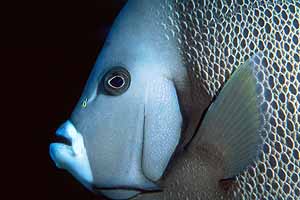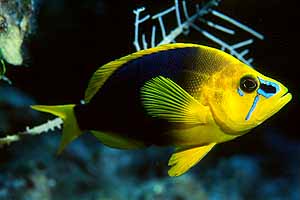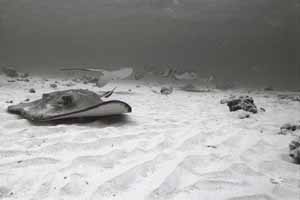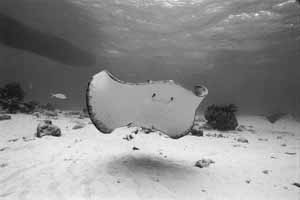February 2001 Grand Cayman Trip ReportText and images Copyright (C) 2001 David M. Read All pictures are hyperlinks. Click on any picture to see a larger version. Be sure to check out the full trip report Photo Gallery!
Getting There & BackGetting there and back just about couldn't be easier. We flew non-stop from Houston Intercontinental, a 2.5-hour flight with no hiccups. Cayman Airways didn't even charge extra fees for the huge amount of gear we brought, well over 175 lbs worth of stuff. The flight back to Houston was uneventful as well, other than a 1-hour delay due to a late flight from Jamaica. The AccommodationsWe stayed at a condo rented out by a private individual. If you're interested in contact info, feel free to email me and I'll shoot you the information. Basically, we lived the life of a native for two weeks. That means we had a car (rented from Andy's), we bought most of our food at the local grocery stores, and we ate most of our meals at home. To be sure, we ate out a few times, but mostly we ate in the condo. Grand Cayman is one of the most expensive places I have ever visited, especially the restaurants. But by cooking our own meals, we were able to keep costs down to a reasonable level. Since we were traveling with our 14-month-old son, being able to cook our own meals and serve him what he likes was a major benefit. Grand Cayman's grocery stores are well-stocked with modern goodies. The big Foster's over by the airport was our favorite place to shop, as it had the best selection of food. The Foster's on Seven Mile Beach (SMB from here on) in the Strand shopping center was a much nicer store, but it was also smaller and much more crowded with shoppers. The various Hurley's stores were the most expensive and the least-stocked, but we were staying within a mile of one, so we shopped there for incidentals. Overall, we loved this experience. We ate on our schedule, comfortably, and weren't stressed out about the costs. We also had several excellent meals after purchasing fresh fish at the local fisherman's "wharf." Downtown in George Town, just south of Don Foster's, is a small sand patch near the harbor. Every day around 3pm, local fishermen pull up their boats and sell their catch. What they have to sell varies, but we were able to buy a couple of nice pieces of grouper for CI$4 per pound, which comes out to US$5/pound. That's pretty good for the freshest fish you'll ever taste. We watched wistfully on two different occasions as they sold the last remaining tuna or jack steaks to a customer in line ahead of us...I guess the moral of the story is to get there early! We also liked the size of the condo. With two bedrooms, 2.5 bathrooms, a kitchen, a living room, and a diving room (plus a back yard and a pool!), we felt much less cramped than we might have in a hotel. Since I travel with two boxes of camera gear, space to spread out is important! The Diving
We did only shore diving with Treasure Island, and we did a trip to Stingray City with them. Thus, I can't tell you much about their operation. The Stingray City trip was a little rushed, but otherwise it was OK. Cayman Diving Lodge's operation was pretty good. The day we dove with them, there were only 4 divers on the boat, so it was a hands-on sort of day from the crew. We drove out to East End to the lodge for a 9:30 boat, did two dives, and drove back. The East End diving wasn't as fantastic as I had been led to believe, but it's quite possible that I had overly inflated expectations. For the most part, I thought Grand Cayman diving was superb. The West Bay and North Wall sites we dove were generally excellent, although the 2nd-dive shallow sites got a little dull after two weeks. Dive Log Excerpts
Dive 3: Oro Verde: Generally dull dive, although there were some highlights. Specifically, discovering a colony of garden eels in the sand at ~45 feet. Very cool. Dive 4: Blue Parrot: Another good dive. The moray and the tarpon were gone, but a large turtle swam by to ham it up for my camera. Dive 5: Round Rock Caves: Now I start to see why Grand Cayman is popular with so many divers. This site is graced with an awesome wall, along with towering pinnacles that expand slightly at the top. This gives the effect of creating arches, mostly-open tunnels, and small caves. Add to this fabulous visibility and tons of fish, and you get a site worth re-visiting. Dive 6: Eagle Ray Pass: Another great dive, this one on Grand Cayman's famous North Wall. The reef starts out as deep sand flats (65 feet), but then as you swim outward the coral builds up to as shallow as ~40 feet, creating a coral ridge maybe 100 feet across. Then it drops off precipitously, with a sheer vertical wall that descends into invisibility and the Cayman Trench. the top of the reef is covered with star coral, sponges, gorgonians, plumes, etc. The wall is all sponges, whips, and fans--and mind-numbing blue water for half of your field of view. Dive 7: Sunset House & Blue Parrot: The surf was up, so I guessed I'd find a little current--and I was right. I walked up to Sunset House and made my entry there, with intentions of locating their "new" mermaid statue. That was no problem--it's hard to miss an 8-foot bronze statue sitting in the 50 feet of crystal clear water. After photographing the mermaid, I availed myself of the current & drifted south towards the Blue Parrot and my exit point. Along the way I ran across a large green moray getting cleaned by shrimp, a young turtle (~12 inches across), and a spotted eagle ray.
Dive 10: Trinity Caves: Awesome dive; another look at the "Round Rock" dive site, although a couple of buoys over. This buoy was situated at the entrance to the reef formations for which this site is named. The Trinity caves are actually three long swimthroughs that are mostly open at the top. There are some overheads, to be sure, but open water and daylight are just a couple of fin kicks away. Dive 11: Doc Poulson: A varied dive site that offers something for everyone. The site is named for the wreck of a cable-laying boat, which sits intact at 50 feet. "Intact" is a relative term, as this boat has gaping holes in it that allow easy penetration and plenty of light. A large snapper inhabits the wheelhouse, which is a photogenic swimthrough. Just north and inshore from the wreck is a large patch reef that bristles with sponges, fans and plumes. Chromis--both blue and brown--inhabit this reef by the thousands. As if all that wasn't enough, when/if you get bored with the wreck, you can swim away from shore to Marty's Wall, which sports a great wall and a brass plaque commemorating the Caymanian native for whom that site is named.
Dive 12: Orange Canyon: Awesome dive! We drifted this dive, starting at orange canyon and going west, past Dolphin Point and on to Northwest Point. The current varied from light to heavy, so we got to spend more time at some parts of the dive than at others. At Orange Canyon the current was pretty light, so we got a nice long look at this great dive site. Orange Canyon starts with a steep slope down to a depth of around 70 feet, where the wall starts in earnest. It's a weird spur-and-groove sort of slope and wall, though. The sides of the spurs are covered in the orange encrusting sponges that give the site its name. Dolphin Point delivered the strongest currents of the dive, a 2+ knot sled ride through forests of giant black fans. No dive is complete without some big creatures, and this dive was complete. The "creature of the week" is the turtle, so of course we saw one. We also saw some lobsters crawling in the sand. But the most memorable big creatures on this dive were the giant supermale parrotfish all over the place. We saw many groups of them cruising the reef, 2 or 3 at a time. 3-4 feet long, dusky orange with green beards, they were an awesome sight. Dive 15: Sand Chute: This dive is very reminiscent of Cozumel, and is easily comparable to Palancar Caves in terms of structure and visibility. The reef towers upwards from a sandy bottom, with many swimthroughs perforating the dropoff. Some of the swimthroughs are wide and partially open, while some are narrow and closed. The site derives its name from a giant sand chute that separates two sections of the reef, starting at 60 feet and continuing down into the depths. The reef structure on either side is completely vertical, with a small overhang at the bottom. Schoolmasters, grunts, and snappers patrol the shadows in these areas, while sponges sample the waters for chow. As always on Grand Cayman, trumpetfish are common, along with GC's strangely common spotted trunkfish, diamond blennies and harlequin bass.
Dive 18: Lone Star: Quite possibly the best shallow dive of the trip. This site has similar topography to the other shallow sites, although it has some small overhangs that simulate swimthroughs. We saw a ton of small stuff, including a small brown moray with gold spots. Anne found a yellow stingray hiding in a tiny hole, half buried in the sand.
Dive 25: The Maze (East End): Cool dive site, with lots of tunnel-like swimthroughs. Plenty of fun if you're a lab rat, but I actually liked the rest of the site much better than the maze itself. We saw a 6-foot reef shark at the beginning of the dive (and again at the end), then we went into the maze. The tunnels are narrow, rocky, vertical cuts in the reef that pass divers pretty much only in single file. Light filters down into the catacombs because most of the maze is open at the top. Despite the name of this site, the best parts of the dive are actually the exterior wall and the reef top. The wall is 100% vertical, and covered with coral, fans, and sponges. Some of the largest black fans I have ever seen were on that wall. The top of the reef had plumes galore, along with yellow sponges and marine life...that was where we spotted the shark. Dive 26: Kelly's (East End): Incredible surge, but fun dive. Lots & lots of swimthroughs are the signature of this site--not the vertical slits of the maze, but overhangs, arches, and sand chutes. In contrast to the maze, Kelly's is just as much fun in the swimthroughs as on top, because Kelly's tunnels have airy dappled light illuminating everything. Rippled sand lines the bottom of most of the tunnels. The top of the reef is covered with Elkhorn coral in various stages of growth, from tiny 6-inch tall young colonies to mighty 5-foot-tall surface-scrapers. The usual assortment of juvenile tenants of Elkhorn coral were in evidence everywhere: yellowtail damselfish, angelfish, etc. Dive 27: Dolphin Point Dropoff: One of West Bay's best dive sites, and awesome combination of wall, sand chutes and swimthroughs. This site also has tons of black fans and orange sponges, along with azure vase sponges, lots of plumes & rods, etc.--and the largest collection of morays on this trip. We saw one or two small spotted morays and 3 large greens. A turtle completed the menagerie (of course). Aside from the wildlife, I love the terrain and scenery. The vis was excellent, too: upwards of 120 feet!
Dive Log Details
|
About | UW Photos | Scuba Picture Uv the Day | Flower Gardens | Aquashot | Trip Reports | RSDiver | Photo Instruction | News | Desktop/Screensaver Images | Site Map |
||














